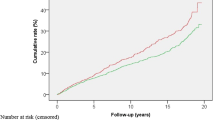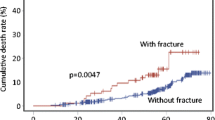Abstract
Summary
Poor physical function and body composition my partly predict the risk of falls leading to fracture regardless of bone mineral density.
Introduction
To examine the relationship between body composition, physical function, and other markers of health with hip fractures in older community-dwelling Icelandic adults.
Methods
A prospective cohort of 4782 older adults from the AGES-Reykjavik study. Baseline recruitment took place between 2002 and 2006, and information on hip fractures occurring through 2012 was extracted from clinical records. Using multivariate regression analyses, baseline measures of bone health, physical function, and body composition were compared between those who later experienced hip fractures and to those who did not. Associations with the risk of fractures were quantified using Cox regression.
Results
Mean age was 76.3 years at baseline. After adjustment for age, regression showed that male hip fracture cases compared with non-cases had (mean (95% confidence interval)) significantly lower thigh muscle cross-sectional area − 5.6 cm2 (− 10.2, − 1.1), poorer leg strength – 28 N (− 49, − 7), and decreased physical function as measured by longer timed up and go test 1.1 s (0.5, 1.7). After adjustment for age, female cases had, compared with non-cases, lower body mass index − 1.5 kg/m2 (− 2.1, − 0.9), less lean mass − 1.6 kg (− 2.5, − 0.8), thigh muscle cross-sectional area − 4.4 cm2 (− 6.5, − 2.3), and worse leg strength − 16 N (− 25, − 6). These differences largely persisted after further adjustment for bone mineral density (BMD), suggesting that body composition may contribute to the risk of fracture independent of bone health. When examining the association between these same factors and hip fractures using Cox regression, the same conclusions were reached.
Conclusions
After accounting for age and BMD, older adults who later experienced a hip fracture had poorer baseline measures of physical function and/or body composition, which may at least partly contribute to the risk of falls leading to fracture.
Similar content being viewed by others
Change history
21 October 2020
The original version of this article, published on 18 august 2020 contained a mistake. An author’s name was misspelled.
References
Peeters CM, Visser E, Van de Ree CL et al (2016) Quality of life after hip fracture in the elderly: a systematic literature review. Injury 47(7):1369–1382
Davis JC, Robertson MC, Ashe MC et al (2010) International comparison of cost of falls in older adults living in the community: a systematic review. Osteoporos Int 21(8):1295–1306
Nasiri M, Luo Y (2016) Study of sex differences in the association between hip fracture risk and body parameters by DXA-based biomechanical modeling. Bone 90:90–98
Briot K, Maravic M, Roux C (2015) Changes in number and incidence of hip fractures over 12 years in France. Bone 81:131–137
Finsterwald M, Sidelnikov E, Orav EJ et al (2014) Gender-specific hip fracture risk in community-dwelling and institutionalized seniors age 65 years and older. Osteoporos Int 25(1):167–176
Xiao Z, Ren D, Feng W, Chen Y, Kan W, Xing D (2016) Height and risk of hip fracture: a meta-analysis of prospective cohort studies. Biomed Res Int 2016:2480693
Steingrimsdottir L, Halldorsson TI, Siggeirsdottir K et al (2014) Hip fractures and bone mineral density in the elderly - importance of serum 25-hydroxyvitamin D. PLoS One:9(3)
Guerra MTE, Feron ET, Viana RD et al (2016) Elderly with proximal hip fracture present significantly lower levels of 25-hydroxyvitamin D. Rev Bras Ortop (Engl Ed) 51(5):583–588
Fiatarone Singh MA (2014) Exercise, nutrition and managing hip fracture in older persons. Curr Opin Clin Nutr Metab Care 17(1):12–24
Lang T, Cauley JA, Tylavsky F et al (2010) Computed tomographic measurements of thigh muscle cross-sectional area and attenuation coefficient predict hip fracture: the health, aging, and body composition study. J Bone Miner Res 25(3):513–519
Marques EA, Elbejjani M, Gudnason V et al (2018) Cigarette smoking and hip volumetric bone mineral density and cortical volume loss in older adults: the AGES-Reykjavik study. Bone 108:186–192
Waugh EJ, Lam MA, Hawker GA et al (2009) Risk factors for low bone mass in healthy 40-60 year old women: a systematic review of the literature. Osteoporos Int 20(1):1–21
Benetou V, Orfanos P, Benetos IS et al (2011) Anthropometry, physical activity and hip fractures in the elderly. Injury 42(2):188–193
Malkov S, Cawthon PM, Peters KW et al (2015) Hip fractures risk in older men and women associated with DXA-derived measures of thigh subcutaneous fat thickness, cross-sectional muscle area, and muscle density. J Bone Miner Res 30(8):1414–1421
Chun SH, Cho B, Yang H-K et al (2017) Performance on physical function tests and the risk of fractures and admissions: findings from a national health screening of 557,648 community-dwelling older adults. Arch Gerontol Geriatr 68(Supplement C):174–180
Frank-Wilson AW, Farthing JP, Chilibeck PD et al (2016) Lower leg muscle density is independently associated with fall status in community-dwelling older adults. Osteoporos Int 27(7):2231–2240
Marks R (2011) Physical activity and hip fracture disability: a review. J Aging Res 2011:741918
Lundin H, Saaf M, Strender LE, Nyren S, Johansson SE, Salminen H (2014) One-leg standing time and hip-fracture prediction. Osteoporos Int 25(4):1305–1311
Pekkarinen T, Löyttyniemi E, Välimäki M (2013) Hip fracture prevention with a multifactorial educational program in elderly community-dwelling Finnish women. Osteoporos Int 24(12):2983–2992
Cummings SR, Nevitt MC, Browner WS et al (1995) Risk factors for hip fracture in white women. N Engl Med 332:767–774
Harris TB, Launer LJ, Eiriksdottir G et al (2007) Age, Gene/Environment Susceptibility-Reykjavik Study: multidisciplinary applied phenomics. Am J Epidemiol 165(9):1076–1087
WHO (2017) The International Classification of Diseases and Related Health Problems 10th Revision (ICD-10)-WHO
Siggeirsdottir K, Aspelund T, Sigurdsson G et al (2007) Inaccuracy in self-report of fractures may underestimate association with health outcomes when compared with medical record based fracture registry. Eur J Epidemiol 22(9):631–639
Aalto H, Pyykko I, Starck J (1988) Computerized posturography, a development of the measuring system. Acta Otolaryngol Suppl 449:71–75
Mijnarends DM, Koster A, Schols JM et al (2016) Physical activity and incidence of sarcopenia: the population-based AGES-Reykjavik Study. Age Ageing 45(5):614–620
Podsiadlo D, Richardson S (1991) The timed “up & go”: a test of basic functional mobility for frail elderly persons. J Am Geriatr Soc 39(2):142–148
Siggeirsdottir K, Jonsson BY, Jonsson H Jr, Iwarsson S (2002) The timed ‘up & go’ is dependent on chair type. Clin Rehabil 16(6):609–616
Rasku J, Pyykko I, Juhola M et al (2012) Evaluation of the postural stability of elderly persons using time domain signal analysis. J Vestib Res 22(5-6):243–252
Sigurdsson G, Aspelund T, Chang M et al (2006) Increasing sex difference in bone strength in old age: the Age, Gene/Environment Susceptibility-Reykjavik study (AGES-REYKJAVIK). Bone 39(3):644–651
Armitage JN, van der Meulen JH (2010) Identifying comorbidity in surgical patients using administrative data with the Royal College of Surgeons Charlson Score. Br J Surg 97(5):772–781
Austin SR, Wong YN, Uzzo RG, Beck JR, Egleston BL (2015) Why summary comorbidity measures such as the Charlson comorbidity index and Elixhauser score work. Med Care 53(9):e65–e72
Zhang X, Yu Z, Yu M, Qu X (2015) Alcohol consumption and hip fracture risk. Osteoporos Int 26(2):531–542
Dargent-Molina P, Favier F, Grandjean H et al (1996) Fall-related factors and risk of hip fracture: the EPIDOS prospective study. Lancet 348(9021):145–149
Robinovitch SN, McMahon TA, Hayes WC (1995) Force attenuation in trochanteric soft tissues during impact from a fall. J Orthop Res 13(6):956–962
Riis BJ, Hansen MA, Jensen AM et al (1996) Low bone mass and fast rate of bone loss at menopause: equal risk factors for future fracture: a 15-year follow-up Study. Bone 19(1):9–12
Kamińska MS, Brodowski J, Karakiewicz B (2015) Fall risk factors in community-dwelling elderly depending on their physical function, cognitive status and symptoms of depression. Int J Environ Res Public Health 12(4):3406–3416
Kear BM, Guck TP, McGaha AL (2017) Timed up and go (TUG) test: normative reference values for ages 20 to 59 years and relationships with physical and mental health risk factors. J Prim Care Community Health 8(1):9–13
EFSA NDA Panel (2016) Scientific opinion on dietary reference values for vitamin D. EFSA J 14:4547. https://doi.org/10.2903/j.efsa.2016.4547
Zarca K, Durand-Zaleski I, Roux C et al (2014) Cost-effectiveness analysis of hip fracture prevention with vitamin D supplementation: a Markov micro-simulation model applied to the French population over 65 years old without previous hip fracture. Osteoporos Int 25(6):1797–1806
Eysteinsdottir T, Halldorsson TI, Thorsdottir I (2015) Cod liver oil consumption at different periods of life and bone mineral density in old age. Br J Nutr 114(2):248–256
Salamon A, Toldy E, Biro C et al (2017) Vitamin D and calcium supplementation in elderly patients with hip fracture. Orv Hetil 43:1699–1707
Choi S-W, Kweon S-S, Choi J-S et al (2015) The association between vitamin D and parathyroid hormone and bone mineral density: the Dong-gu Study. J Bone Miner Metab 34:555–563
Skuladottir SS, Gudmundsdottir E, Mogensen B, et al (2018) Hip fractures among older people in Iceland between 2008 and 2012. Int J Orthop Trauma Nurs
Funding
The original work was funded by the National Institutes of Health, USA, contract N01-AG-12100, and the National Institute on Aging Intramural Research Program, the National Eye Institute, USA (ZIAEY000401), Hjartavernd (The Icelandic Heart Association), and Althingi (Icelandic Parliament). Work on this study was in part funded by The St. Josef’s Hospital Fund, Reykjavik, Iceland, the Landspitali University Hospital Research Fund, the Icelandic Gerontological Society Research Fund, and the Helga Jonsdottir and Sigurlidi Kristjánsson Geriatric Research Fund.
Author information
Authors and Affiliations
Corresponding author
Ethics declarations
All participants provided written informed consent. The study was approved by the Icelandic National Bioethics Committee (VSN: 00-063) and the National Institute on Aging Intramural Institutional Review Board (MedStar IRB for the Intramural Research Program, Baltimore, MD).
Conflicts of interest
None.
Additional information
Publisher’s note
Springer Nature remains neutral with regard to jurisdictional claims in published maps and institutional affiliations.
The original version of this article was revised: An author’s name was misspelled
Electronic supplementary material
ESM 1
(DOCX 31 kb)
Rights and permissions
About this article
Cite this article
Skuladottir, S.S., Ramel, A., Hjaltadottir, I. et al. Characteristics of incidence hip fracture cases in older adults participating in the longitudinal AGES-Reykjavik study. Osteoporos Int 32, 243–250 (2021). https://doi.org/10.1007/s00198-020-05567-x
Received:
Accepted:
Published:
Issue Date:
DOI: https://doi.org/10.1007/s00198-020-05567-x




